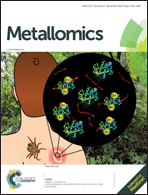金属硫蛋白对必需金属离子和有毒金属离子的亲和力、选择性和结构域特异性的热力学起源。
IF 2.9
3区 生物学
Q3 BIOCHEMISTRY & MOLECULAR BIOLOGY
引用次数: 0
摘要
富含 Cys 的小型蛋白质金属硫蛋白(MT)可在其两个结构域内与多种金属离子结合成簇。虽然对 MT 与有毒和必需金属的亲和力已有深入研究,但对这种结合的热力学却没有深入研究。我们使用等温滴定量热法测量了金属离子与 MT 的两种无处不在的异构体结合时的焓变化(ΔH)和熵变化(ΔS)。在 pH 值为 7.4 的条件下,7 个 Zn2+ 依次与金属离子结合,形成两个具有不同配位热力学的族群:最初的 4 个 Zn2+ 以单独的四硫代硫酸盐配位随机结合,随后的 3 个 Zn2+ 以桥状硫代硫酸盐配位结合,形成金属簇。MT 对这两个群体的高亲和力是由于非常有利的结合熵远远超过了不利的结合焓。这源于 Zn2+ 从 Cys 硫醇中置换质子时产生的净焓损失,以及置换质子产生的有利熵贡献。其他金属离子与 MT 结合的热力学是通过它们从 Zn7MT 中置换出 Zn2+ 并减去 Zn2+ 结合热力学而确定的。有毒的 Cd2+、Pb2+ 和 Ag+,以及基本的 Cu+,也以非常有利的结合熵与 MT 结合,但随着金属离子变成较软的路易斯酸,其净结合焓变得越来越有利。这些热力学是 MT 对这些金属离子具有高亲和力、选择性和域特异性的根源,也是它们在体内进行结合竞争的分子基础。本文章由计算机程序翻译,如有差异,请以英文原文为准。
Thermodynamic origin of the affinity, selectivity and domain specificity of metallothionein for essential and toxic metal ions.
The small Cys-rich protein metallothionein (MT) binds several metal ions in clusters within its two domains. While the affinity of MT for both toxic and essential metals has been well studied, the thermodynamics of this binding has not. We have used isothermal titration calorimetry measurements to quantify the change in enthalpy (ΔH) and change in entropy (ΔS) when metal ions bind to the two ubiquitous isoforms of MT. The seven Zn2+ that bind sequentially at pH 7.4 do so in two populations with different coordination thermodynamics, an initial four that bind randomly with individual tetra-thiolate coordination and a subsequent three that bind with bridging thiolate coordination to assemble the metal clusters. The high affinity of MT for both populations is due to a very favourable binding entropy that far outweighs an unfavourable binding enthalpy. This originates from a net enthalpic penalty for Zn2+ displacement of protons from the Cys thiols and a favourable entropic contribution from the displaced protons. The thermodynamics of other metal ions binding to MT were determined by their displacement of Zn2+ from Zn7MT and subtraction of the Zn2+-binding thermodynamics. Toxic Cd2+, Pb2+ and Ag+, and essential Cu+, also bind to MT with a very favourable binding entropy but a net binding enthalpy that becomes increasingly favourable as the metal ion becomes a softer Lewis acid. These thermodynamics are the origin of the high affinity, selectivity and domain specificity of MT for these metal ions and the molecular basis for their in vivo binding competition.
求助全文
通过发布文献求助,成功后即可免费获取论文全文。
去求助
来源期刊

Metallomics
生物-生化与分子生物学
CiteScore
7.00
自引率
5.90%
发文量
87
审稿时长
1 months
期刊介绍:
Global approaches to metals in the biosciences
 求助内容:
求助内容: 应助结果提醒方式:
应助结果提醒方式:


